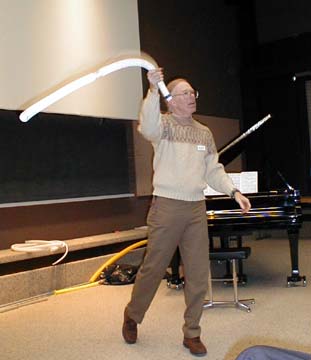
Paul plays the whirly
by Paul Doherty
An invited presentation at the annual AAAS meeting, San Francisco, 2001

Paul plays the whirly
The Presentation I began by twirling the three foot long
children's toy whirly over my head playing a series of notes
up and down the scale. "I fell in love with the sounds of
the whirly the first time I heard children playing them in
the Exploratorium store. Whirlies only play notes which
sound good together.
No matter how I swing it around, it
only plays certain notes. It does not slide from note to
note it jumps. It thus behaves like the electron in an atom
which jumps between energy levels. The whirly plays quantum
music." After I had played the toy whirly for a
while I got tired of the same five notes and began looking
for other corrugated singing tubes. I conceived of a plan to
incorporate the whirly into symphony orchestras. I
envisioned a whole new orchestral section based on
corrugated plastic tubes: the corrugahorn section.
That set me on a search for the full
range of instruments from alto to bass. My first experiments
were geared toward finding bass
instruments.
One day, my wife Ellen and I were at a friend's swimming
pool. In the pool I spotted a surface vacuum cleaner
trailing a long flexible corrugated hose. Ellen impressed me
with her speed as she stopped me from unfolding the blade of
my knife. She talked me into waiting a day and buying my own
hose from a swimming pool supply store. At the store I
purchased my first swimming pool vacuum hose
whirly. I played a few notes and they rang out
loud and clear in the room. One day a professional whirly player came
to the Exploratorium, Sarah Hopkins. She had a question for
me, how do whirlies sing their songs. I was pleased to be able to give her a
short complete answer,"I don't know." She laughed and said
that she had already asked two physicists and received two
different answers. I suggested we do some experiments. While
we worked together Sarah tuned a whirly for me and taught me
to play a piece of music she composed for it, "Deep Whirly
Heartsong." Let me play it for you. The performance whirly filled the hall
with sound. As the last note faded away the audience
applauded and cheered. We began to discover how whirlies
work. Sarah pointed out that whirlies didn't
play their fundamental note. We then went for a ride in a car and
stuck the whirly out the window we found that the frequency
of the notes went up proportional to the speed of the
car. We held the whirly perpendicular to the
airflow out the window of the car, it did not sing, yet held
pointing into the airflow it sang loudly. On stage, I blew across the end of the
whirly to show it would not sing, then blew into it to make
it sing. We were doing experiments and making
progress. More tests were needed. We reasoned that
longer whirlies would play lower frequencies. I played a whirly twice as long as the
last one. "Note the lower pitch of the lowest note
of the longer whirly." The whirlies only sing sound waves which
fit in them exactly, longer tubes mean longer soundwaves
which have lower pitch. It got to the point where my wife hated
to go into hardware stores with me. and, "I was thrilled to find something to
do with my left hand." Just like the Mr. Toad who was stricken
with automobile fever, I was smitten with whirlies. When I
went to visit friends they hid their china and lamps. The
children loved me though. The bag whirly! After I played half a bagful of notes, I
removed the bag from my underarm and played the whirly in my
usual swinging way. The whirly sang and sucked the remaining
air from the bag. The singing stopped when the bag was
empty. I looked quizzically at the quiet whirly and its
deflated bag and said, of course, "pardon me but my
instrument seems to be a little flat tonight." (This time
the audience groaned.) Whirly discoveries came fast and
furious. "I have." I still longed for deeper notes. Normally, I would start to spin A loud
low tone would grow to fill the room. However at the AAAS I didn't have enough
room to play the bass whirly by spinning it. I looked at the
tables filled with Bassam Shakashiri's chemical glassware,
took the whirly in both hands and with a fiendish gleam in
my eye said, "be afraid Bassam, be vary afraid!" Then I
laughed and got out my blower and used it to play the deep
notes from the bass whirly. Holding the blower close made
the whirly sing high pitches, further away deep low notes. I
ended with a deep low note, then said, "at last I had found
all of the instruments needed to fill the corrugahorn
section of the orchestra." The room erupted with cheers and
applause. WOW. I sure had fun at this lecture.
The Science A corrugated plastic tube will sing notes
when swung overhead. Hold one end in your hand. What notes does the whirly
play? If you are musically trained or have a
person who is musically trained in a class ask them to
identify the interval between the lowest note played by the
whirly and the next highest note. They will tell you it is a
musical 5'th. What that translates to is that the notes have
a frequency ratio of 3/2. If these two notes were the
fundamental and the next harmonic they would be in the ratio
of 2/1 a musical octave apart, yet they are not. Most meter
long whirlies do not play the fundamental note. The reason
why will not appear until later. If you have a frequency
meter you can measure the frequencies directly, my tube sang
at 220 Hz and 330 Hz. The interval between the second and
third notes is a musical third a ratio of 4/3. Why are the musical notes of the
whirly quantized? A tube open at both ends has only certain
harmonic frequencies at which it will resonate. These are
the frequencies at which an integer number of
half-wavelengths of sound fit inside the length of the tube.
At the fundamental frequency one-half wavelength fits in the
tube. A 1.5 meter long tube would have a 3
meter wavelength, L, sound wave at resonance. The frequency,
f, would be f = c/L where c is the speed of sound in the
tube. The speed of sound in air depends on temperature but
is near 340 m/s. However measurements on the whirly show
that the speed of sound in the whirly is near 330 m/s. So
the fundamental resonant frequency of a tube would be 110
Hz. The tube resonates to integer multiples
of this fundamental frequency. Longer whirlies have a lower frequency
fundamental, the harmonic frequencies are closer together,
spaced apart by the lower frequency of the
fundamental. Resonances of the tube Hold one end of the whirly near your ear
and the other end near your mouth. What makes the whirly sing part
1 One often heard yet incorrect hypothesis
for what makes the whirly sing is that air rushes past the
rotating open end at a high speed creating a low pressure
area due to the Bernoulli effect and that the difference in
pressure between the stationary end at atmospheric pressure
and the moving end pushes the air through the tube. To show
that this is incorrect blow across the end of the tube with
your mouth or any other blower. (Footnote: Why
it is not the Bernoulli effect.)
The whirly cannot be made to sing by air flowing across the
end! Next blow through the tube. Hold your mouth a few
inches from the end and blow, it will sing pure notes. Blow
faster and the notes increase in pitch. While playing the whirly: Taking whirlies for a car
ride. Take the whirly along with you in a car.
Stick one end out the window slowly increase your speed note
the speeds at which it sings each note the loudest. For my
whirly I found that it sang notes at speeds near 20 mph, 30,
mph, 40, mph and 50, mph. The frequencies of these notes
were 220,330,440 and 550 Hz. A plot of frequency versus
speed shows that the frequency of the whirly is proportional
to the speed of the car. Measuring the speed of the tip of the
whirly You can also play a note and find the
speed of the tip of the whirly, as you spin it, estimate the
circumference of the circle scribed by the end of the whirly
then time how long it takes to complete the circle (I
usually time 10 rotations to improve the accuracy of my
measurement.) Once again a graph of frequency versus speed
will show that he frequency of the whirly is proportional to
the speed of the rotating end. Why spinning the tube makes air flow
through it Picture the whirly full of marbles, if
you swing the whirly the marbles will be launched out the
moving end at high speed. The same happens to the air. Twirl
the whirly and you launch the air out of it. Twirl it faster
and the air moves through it faster. Longer whirlies sing two notes at
once Make a longer whirly, perhaps 3 meters
long. Play it. Notice that it sometimes sings two adjacent
notes at once. The Bag whirly Tape a plastic garbage bag to one end of
the whirly. Use a blower to inflate the bag. What makes the whirly sing part
2. To sing, the tube must be corrugated on
the inside. Aerodynamics researchers in Japan put a
whirly in a wind tunnel and used very tiny hot wire
anemometers to measure the airflow near the
corrugations. They discovered that air flowing over two
successive corrugations in the wall of the whirly
experienced But why doesn't the whirly play the
fundamental note? To drive the resonant frequencies of the
tube, air must flow in an eddying instability over each
ridge in the whirly. This means that there must be turbulent
flow of air in the tube. At low speeds the air can flow
through the whirly tube smoothly, this is called laminar
flow, such a smooth and quiet laminar flow will produce no
turbulent eddies to create sound frequency oscillations
which drive the resonant frequencies of the tube. The spiral myth There is a persistent myth that whirlies
with ridges that spiral around them will not sing. However I
posses several spiral ridged whirlies that sing loud clear
tones. Why it is not
the Bernoulli Effect Many people first guess that the air
blowing across the end of the whirly reduces the pressure at
the end of the whirly due to the Bernoulli effect and sucks
air through the whirly. The simple experiment of blowing
across the end of the whirly shows that this guess is
incorrect. While the air does speed up as it flows over the
end of the whirly, and while this speeding up is accompanied
by a drop in pressure according to the Bernoulli effect,
simple experiments given above show that this drop in
pressure plays a minor role in making the air flow through
the tube.
I kept blowing into and whirling every piece of corrugated
hose I could find; gas pipes, electrical conduit and
electrical wire guides... like these."
I picked up the two "Fly" whirlies.
I reasoned I could play them by pushing their ends through
the air.
I began to play 'Fly' (another Sarah Hopkins composition.)
by arcing the two whirlies from above my shoulders down
across the front of my body.
"When I play this I find that I can walk through all
neighborhoods of San Francisco and no one will ask me for
change! This motion allowed me to combine music, physics and
self-defense!"
I segued into the second part of 'Fly' which involves
swinging the two whirlies alternately, then into the finish
with arcing moves again. The audience applauded.
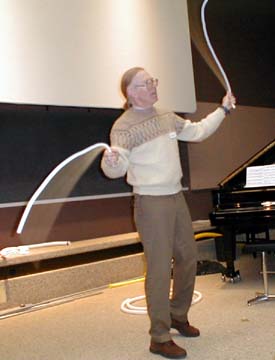
" One day a friend made the comment that my music was not
very multicultural. I took his words to heart."
I picked up a toy whirly attached to a 5 gallon plastic bag.
I filled the bag with air from a battery operated leaf
blower. The audience giggled at the sight of a turgid bag
attached to a whirly, then laughed aloud as I tucked the
whirly under my arm and they figured out what I was going to
do. I played the bag whirly by squeezing the bag under my
arm.
I was pleased to find the answer to my search for
multicultural whirlies among my own Celtic
roots...
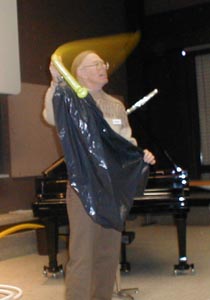
I found my highest pitched instrument in a 7-11."
I pick up a large plastic cup pull out the corrugated straw
and blow a few notes making high pitched sounds.
"Have you ever been thrown out of a 7-11?"
Then one day at a winery my attention was riveted by a piece
of hosing. My wife shouted "NO!" But she was too late I had
found the Mount Everest of whirlies &emdash; agricultural
drain hose. It was three inches in diameter and twelve feet
long."
I picked up my giant whirly and held it, coiled around me on
the stage looking at it in a perplexed way.
The only problem was how could I play it?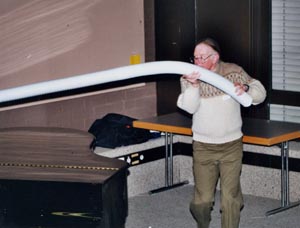

A corrugated plastic tube open at both ends
Twirl the other end in a circle.
Listen to the sound made by the tube.
Vary the speed of the tube.
Notice that the pitch of the whirly jumps from one note to
another and increases as the speed of the twirling is
increased.
That is, high speed twirling creates high pitch
notes.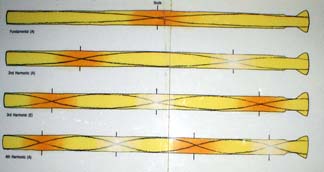
A physics image of the sound in a whirly, click to
enlarge.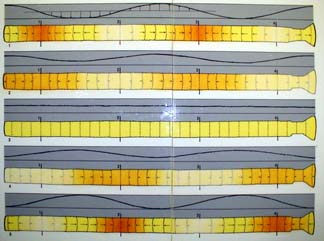
A movie of air motion in a whirly, click on the image to
enlarge.
Hum into the whirly. Vary the pitch of your humming while
you try to keep the loudness of the humming (heard by the
ear not next to the whirly) the same. Notice that at some
frequencies the tone heard in the whirly is louder. When you
hum at a resonant frequency of the tube your humming is
amplified and sounds louder. (You can also drive the whirly
with a frequency generator and a speaker.) Notice that the
resonances occur at the same frequencies the whirly sings.
Except for the fundamental. There is a resonant
amplification of your humming at the fundamental frequency
yet the whirly will not play the fundamental.
1. Cover the stationary end with your hand. Notice that the
sound stops immediately.
2. Hold the stationary end near the burning candle, notice
that the flame bends into the whirly.
3. Hold the stationary end of the whirly near a pile of
confetti, or other small paper pieces. Notice that when the
whirly is signing a note the paper pieces flow into the
whirly and are sprayed around.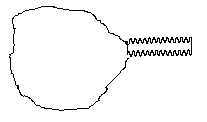
(You can also inflate the bag by blowing into the bag with
your mouth. If you blow into the bag do not press your mouth
against the whirly, hold your mouth a few inches from the
end of the whirly to promote entrainment of surrounding air,
this will increase the flow of air into the bag and decrease
the time it takes to fill the bag.)
Squeeze the bag and you can play the whirly.
Squeeze hard to get high pitch notes, squeeze softly to get
lower pitches.
You can measure the speed of airflow through the whirly, s,
in m/s by measuring the volume of the bag, V, in
m3 the cross sectional area of the whirly, a, in
m2 and the time it takes to empty the bag, t, in
seconds while playing one note.
The speed will be s = V/at.
Check the units, they are meters per second.
"impinging shear flow instability."
This is the same effect that makes a tea kettle sing. If you
look at the spout of a teakettle you will see that it has
two disks separated by a short gap, each with a hole in its
center. When the air, or steam, flows through the first hole
and then flows through the second hole it exits in vortices
which cause oscillating pressure in the air, heard by the
human ear as a whistle. The ridges in the whirly tube play
the same role. As the air flows first over one ridge then
over a second it tumbles into a vortex. The faster the air
flows through the tube the higher the frequency of the sound
produced by the vortex. When the frequency of the vortex
matches one of the natural resonant frequencies of the tube
it is amplified.
|
Scientific Explorations with Paul Doherty |
|
21 Feb 2001 |